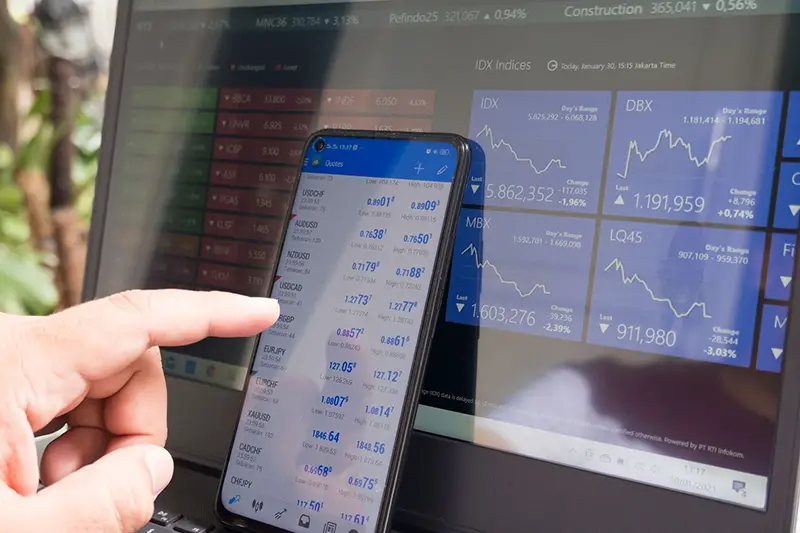Click here to get this post in PDF
One of the most popular stock patterns for day trading that you should know is the triangle pattern, which comes in three variations: the symmetrical triangle, the ascending triangle, and the descending triangle.
They are significant trends for various reasons: they indicate a reduction in uncertainty that could grow once more in the future. Triangles offer analytic insight into present circumstances as well as measures of potential future conditions. The triangle pattern also offers trading options both when it’s developing and after it’s done.
Ascending Triangle
The ascending triangle, also known as the ‘rising triangle,’ is among the most common mid-trend continuity trends. Market participants expect the market to proceed in the broader trend and create investing strategies to reflect this.
The ascending triangle is a bullish continuity pattern with an increasing lower trendline and a flat upper trendline acting as support. As prices keep making higher lows, this trend shows that buyers are more competitive than sellers. As the value goes out of the triangle in the general trend, the pattern is completed.
The ascending triangle’s position concerning the pattern will decide if a trend reversal or continuity is possible. The ascending triangle will emerge at the base of a downtrend, signaling that the downward momentum is weakening and that the pattern could be changing direction. As a result, the pattern’s position is extremely significant.
A descending triangle is also available, which is a continuation pattern. The descending triangle varies from an ascending triangle in that its lower trendline is horizontal, while its higher trendline is going downwards. The ascending triangle pattern, on the other hand, is the polar opposite. An increasing lower trendline can be seen in this situation, converging to follow a very horizontal upper trendline.
Identifying an Ascending Triangle
When traders know what to watch for, the ascending triangle is pretty easy to find on forex maps.
- Uptrend: Before the ascending triangle arises, the stock should be in an uptrend. This is significant because it highlights traders’ role, not merely trading the ascending triangle as it emerges.
- Consolidation: Once the stock market starts the consolidation process, the ascending triangle begins to take shape.
- Growing lower trendline: An increasing trendline can be established by linking the lows when the market is consolidating. This rising trendline indicates that traders gradually move the market higher, adding to the bullish trading bias.
- Flat Upper Trendline: The upper trendline is flat and serves as resistance. This point is often approached by price, which bounces off before a breakout happens.
- Continuation of Trend: Traders would look for evidence of the pattern through maintained upward movement after price makes a solid break over the upper trendline.
How to Measure an Ascending Triangle
The ascending triangle has a built-in calculating method that can be used to estimate possible taking benefit goals. Traders will calculate the distance from the pattern’s origin, at the lowest point of the rising trendline, to the ascending triangle’s flat support line. Afterward, beginning from the breakout point and stopping at the future take advantage stage, the same gap can be transposed.
Trading with an Ascending Triangle
When selling the ascending triangle, there are two major methods to choose from, each with its own set of benefits and drawbacks.
- The first and most straightforward method is to purchase the breakout above resistance. This, along with the higher lows, should provide you with the necessary assurance to enter a trade.
- Buying the dip is another choice. Remember that the dips can form a triangle shape, making it simple to predict the next dip. The problem is that there is no guarantee that the pattern will succeed. It should maintain the current trend; however, failure is still a probability. This is a bit more advanced, and it necessitates fast decisions to minimize damages when you’re incorrect. However, the future benefits from this approach could be greater.
Traders must recognize the uptrend when selling the ascending triangle. For instance, as the forex candlesticks begin to consolidate, the ascending triangle emerges. As traders expect the breakout, the measurement procedure can be used after the triangle has formed. Traders will enter a long position after seeing a good break over resistance, setting a stop at the recent swing low, and a take benefit goal under the measuring technique.
Advantages of an Ascending Triangle
Following are the advantages of an ascending triangle:
- It’s simple to spot the pattern.
- Based on the ascending triangle’s maximum height, it generates a simple goal standard.
- Because this is an intermediate-term pattern, traders will trade inside it, but they should sort trades in the trend’s direction.
Disadvantages of an Ascending Triangle
Following are the disadvantages of an ascending triangle:
- False breakouts will likely occur, and traders should manage risk accordingly.
- There is often the possibility that the price will drift sideways or much below for a longer length of time.
The ascending triangle pattern is a very effective chart pattern that takes advantage of consumer supply and demand imbalances. You can get a perfect head start with the ascending triangle and see the trading chance before it occurs. As a result, being able to understand the ascending triangle pattern can be a useful method for spotting lucrative trades.
You may also like: The risk-reward ratio in Forex trading
Image source: Unsplash.com

